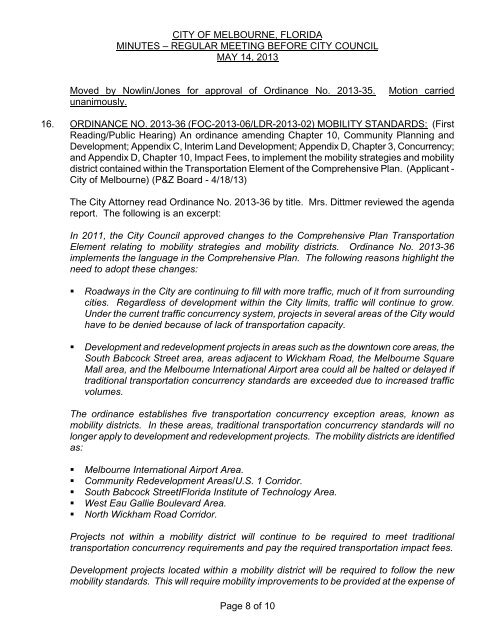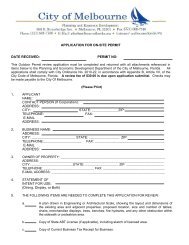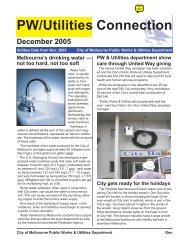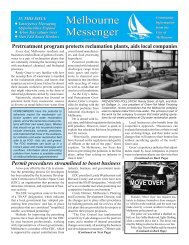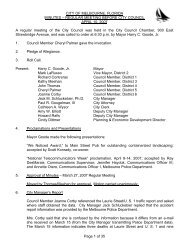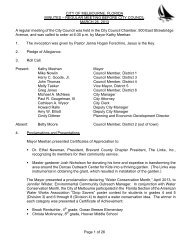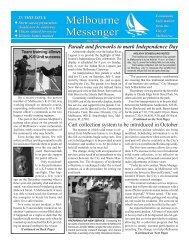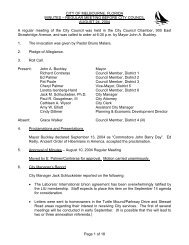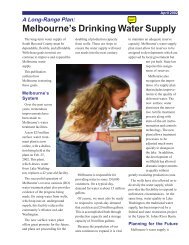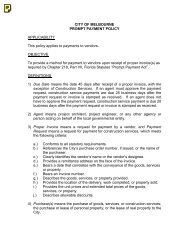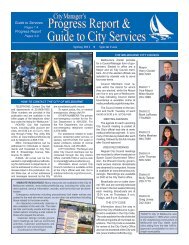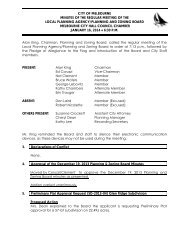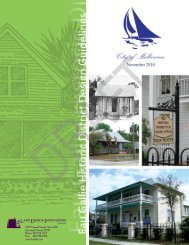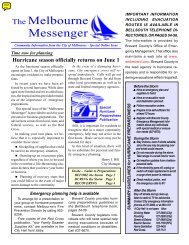May 14 - City of Melbourne, Florida
May 14 - City of Melbourne, Florida
May 14 - City of Melbourne, Florida
You also want an ePaper? Increase the reach of your titles
YUMPU automatically turns print PDFs into web optimized ePapers that Google loves.
CITY OF MELBOURNE, FLORIDA<br />
MINUTES – REGULAR MEETING BEFORE CITY COUNCIL<br />
MAY <strong>14</strong>, 2013<br />
Moved by Nowlin/Jones for approval <strong>of</strong> Ordinance No. 2013-35. Motion carried<br />
unanimously.<br />
16. ORDINANCE NO. 2013-36 (FOC-2013-06/LDR-2013-02) MOBILITY STANDARDS: (First<br />
Reading/Public Hearing) An ordinance amending Chapter 10, Community Planning and<br />
Development; Appendix C, Interim Land Development; Appendix D, Chapter 3, Concurrency;<br />
and Appendix D, Chapter 10, Impact Fees, to implement the mobility strategies and mobility<br />
district contained within the Transportation Element <strong>of</strong> the Comprehensive Plan. (Applicant -<br />
<strong>City</strong> <strong>of</strong> <strong>Melbourne</strong>) (P&Z Board - 4/18/13)<br />
The <strong>City</strong> Attorney read Ordinance No. 2013-36 by title. Mrs. Dittmer reviewed the agenda<br />
report. The following is an excerpt:<br />
In 2011, the <strong>City</strong> Council approved changes to the Comprehensive Plan Transportation<br />
Element relating to mobility strategies and mobility districts. Ordinance No. 2013-36<br />
implements the language in the Comprehensive Plan. The following reasons highlight the<br />
need to adopt these changes:<br />
• Roadways in the <strong>City</strong> are continuing to fill with more traffic, much <strong>of</strong> it from surrounding<br />
cities. Regardless <strong>of</strong> development within the <strong>City</strong> limits, traffic will continue to grow.<br />
Under the current traffic concurrency system, projects in several areas <strong>of</strong> the <strong>City</strong> would<br />
have to be denied because <strong>of</strong> lack <strong>of</strong> transportation capacity.<br />
• Development and redevelopment projects in areas such as the downtown core areas, the<br />
South Babcock Street area, areas adjacent to Wickham Road, the <strong>Melbourne</strong> Square<br />
Mall area, and the <strong>Melbourne</strong> International Airport area could all be halted or delayed if<br />
traditional transportation concurrency standards are exceeded due to increased traffic<br />
volumes.<br />
The ordinance establishes five transportation concurrency exception areas, known as<br />
mobility districts. In these areas, traditional transportation concurrency standards will no<br />
longer apply to development and redevelopment projects. The mobility districts are identified<br />
as:<br />
• <strong>Melbourne</strong> International Airport Area.<br />
• Community Redevelopment Areas/U.S. 1 Corridor.<br />
• South Babcock Street/<strong>Florida</strong> Institute <strong>of</strong> Technology Area.<br />
• West Eau Gallie Boulevard Area.<br />
• North Wickham Road Corridor.<br />
Projects not within a mobility district will continue to be required to meet traditional<br />
transportation concurrency requirements and pay the required transportation impact fees.<br />
Development projects located within a mobility district will be required to follow the new<br />
mobility standards. This will require mobility improvements to be provided at the expense <strong>of</strong><br />
Page 8 <strong>of</strong> 10


